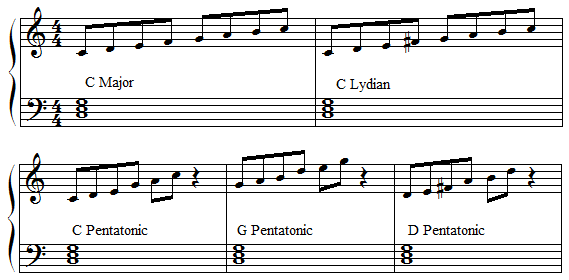Once you've learned the basic melody types of skipping and stepping to create melodies you move on to which scale to use. This involves using more than just a basic major or minor scale and moving into new choices.
Much of what I'm going to discuss here is advanced theory and my intent is to expose the beginner and intermediate student to concepts to plant seeds for future success. So if you don't get it, no problem, experiment and see what you can pick up. Just one thing will help you grow.
Scale Modes
In the creating melodies basic types an introduction to modes was given to you to play and experiment to try improvising or composing your melody. In order to choose a mode you have to understand the function of the chord. For most of us it is in understanding the concept of where in the harmonic system the chord is and what mode goes with that chord.
To review go to the page at the main site: Scale Modes. Learning the modes in different keys is as easy as learning the major scale for that key and then playing it from the root of the chord. (2 to 2 or 5 to 5 and so on). OK I made it sound easy, but I still have to think my way through it. It really takes spending time with the key signature, it's chords and the scale.
Bottom line this is always a good way to work with different keys and melody notes.
Other Scales
If you've taken time to explore other types of scales you realize that you may have other choices such as pentatonic, blues, diminished, and whole note scales. Any of which may or may not work for a given situation. With 12 chromatic tones each with an ability to have four or so sevenths for a function within a harmonic system this could get completely out of control to teach.
So let's start slow and work just one chord and then give you a method to explore options in your composition or improvisation style.
5 Scale Choices for CM7
Here are five scale choices you can use for the C major 7th chord:
C Major – no big surprise there.
C Lydian mode – C scale sharp the 4th adds a new sound – try it
C Pentatonic – Just 5 notes of the C scale
G Pentatonic – A different 5 notes of the C Scale
D Pentatonic – uses 5 notes of the Lydian mode
Go here: Pentatonic Scales to refresh on these scales

Now you have plenty to experiment with to get started on learning the use of different scales for your chord.
Discovering a new scale for your chord.
Don't know what scale to choose? Don't even know what the scales are? Let me give you a way to explore potential new scales. This is a great learning game and will really help you expand your mind to the possiblities.
For any one chord you will have 3 or 4 notes that must fit into a scale. Write these out on your staff paper. Work with a a 7th or major 7th chord to really make you think.
For a pentatonic scale you may add one more note to your seventh. Make it fit into your chord notes. In some cases it may even be a minor pentatonic scale.
If you want to build a 7 note scale, you can pick any of the none chord tones, but I only want you to start by using only one note name. That is if you choose an Eb then E is no longer available, but you might call it an Fb and F and F# will no longer be available.
Write this out and see what kind of a scale you come up with. It might be one you already know or it just might be one you haven't played before. Be sure to audition and see what cool sound you created.
We'll explore more in future posts for creating melodies.